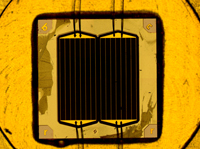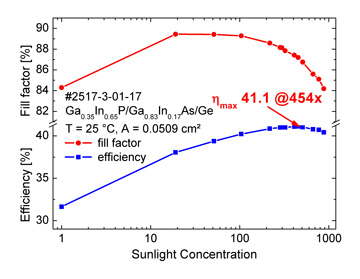

| Home | About Us | Contribute | Bookstore | Advertising | Subscribe for Free NOW! |
| News Archive | Features | Events | Recruitment | Directory |
| FREE subscription |
| Subscribe for free to receive each issue of Semiconductor Today magazine and weekly news brief. |
News
15 January 2009
Fraunhofer ISE raises multi-junction solar cell efficiency record to 41.1%
After raising its European record for solar cell efficiency from 37.6% to 39.7% between last July and September, the Fraunhofer Institute for Solar Energy Systems (FhG-ISE) in Freiburg, Germany has achieved a new world record for multi-junction solar cells (exceeding the record of 40.8% set in August by the US Department of Energy’s National Renewable Energy Laboratory).
 Such high-efficiency multi-junction solar cells are targeted at use in concentrating photovoltaic (CPV) systems for solar power plants in countries with a large fraction of direct solar radiation. At a sunlight concentration factor of 454 suns for the small 5mm² multi-junction solar cell, a record conversion efficiency of 41.1% was achieved. Even at a higher concentration of 880 suns, an efficiency of 40.4% was measured, as the cell shows an efficiency of more than 40% over a fairly broad range of concentration factors.
Such high-efficiency multi-junction solar cells are targeted at use in concentrating photovoltaic (CPV) systems for solar power plants in countries with a large fraction of direct solar radiation. At a sunlight concentration factor of 454 suns for the small 5mm² multi-junction solar cell, a record conversion efficiency of 41.1% was achieved. Even at a higher concentration of 880 suns, an efficiency of 40.4% was measured, as the cell shows an efficiency of more than 40% over a fairly broad range of concentration factors.
Picture (above): Record Ga0.35In0.65P/Ga0.83In0.17As/Ge solar cell, with a cell area of 5.09mm².
Like FhG-ISE’s previous record cells, the new cell uses a metamorphic (lattice mismatched) triple-junction Ga0.35In0.65P/Ga0.83In0.17As/Ge layer structure (gallium indium phosphide and gallium indium arsenide on a germanium substrate). In contrast to conventional solar cells, the semiconductor materials in the separate layers do not have the same crystal lattice constant, and can only be combined by using metamorphic growth. This makes it difficult to grow layers with high crystal quality since, at the interface of materials with different lattice constants, strain is present that results in the creation of dislocations and other crystal defects.
Led by Dr Frank Dimroth, head of its III-V – Epitaxy and Solar Cells group, Fraunhofer ISE has overcome this obstacle by localizing the defects in an electrically inactive region of the solar cell. The active regions hence remain relatively defect free – a prerequisite for achieving the highest efficiencies. “This is an especially good example of how the control of crystal defects in semiconductors can lead to a breakthrough in technology,” says Fraunhofer ISE’s director, professor Eicke R. Weber.
Metamorphic crystal growth enables use of a much larger range of III-V compound semiconductors for growing multi-junction solar cells. For these highly efficient structures, the solar spectrum is divided into three equally large spectral regions by a suitable choice of light-absorbing materials.
The researchers says that this is an important argument in favor of a serial-connected solar cell, where the device current is limited ultimately by the smallest current generated by one of the subcells. By choosing the metamorphic Ga0.35In0.65P/Ga0.83In0.17As/Ge material combination, a solar cell structure could be chosen that is completely current matched under the terrestrial solar spectrum (i.e. all three subcells of the triple-junction solar cell generate the same amount of current). This is a key reason for the achievement of the high efficiencies, Dimroth says.

Graphic (above): Efficiency versus concentration factor (measured by Fraunhofer ISE's CalLab).
Fraunhofer ISE raised the efficiency from 37.6% to 39.7% last year by improving the contact structures of the solar cells through using a front-side network of thin metal wires that transport large currents but with low resistance. Such cells are suited to inhomogeneous radiation, as occurs for concentration factors of 300-600 suns. Dimroth says that the latest efficiency of 41.1% has been achieved by changing the grid layout, optimizing it for the 300-500 concentration range.
To make the technology competitive with established technologies as quickly as possible, Fraunhofer ISE is working together with cooperation partner Azur Space of Heilbronn, Germany as well as spin-off firm Concentrix Solar GmbH in Freiburg. “The high efficiencies of our solar cells are the most effective way to reduce the electricity generation costs for concentrating PV systems,” says Dr Andreas Bett, Department Head at Fraunhofer ISE. He adds that Fraunhofer ISE wants photovoltaics to become competitive with conventional methods of electricity production as soon as possible. “With our new efficiency results, we have moved a big step further towards achieving this goal.”
Dimroth says that he sees further potential to improve the cell structure to achieve efficiencies up to the 42-43% range.
Over the last 15 years, Fraunhofer ISE’s research on III-V multi-junction solar cells for concentrating photovoltaics has been supported initially by the German Federal Ministry of Education and Research (BMBF) and later also by the German Federal Ministry for the Environment, Nature Conservation and Nuclear Safety (BMU). The Deutsche Bundesstiftung Umwelt (DBU) also contributed financially by providing several grants for doctoral students.
See related items:
LayTec to develop in-situ sensor for ISE’s triple-junction PV cells
Fraunhofer ISE raises Euro PV efficiency record to 39.7%
NREL sets solar cell efficiency record of 40.8%
![]() Search: Triple-junction solar cell CPV Germanium substrate MOCVD GaInP GaInAs
Search: Triple-junction solar cell CPV Germanium substrate MOCVD GaInP GaInAs
Visit: www.ise.fraunhofer.de
